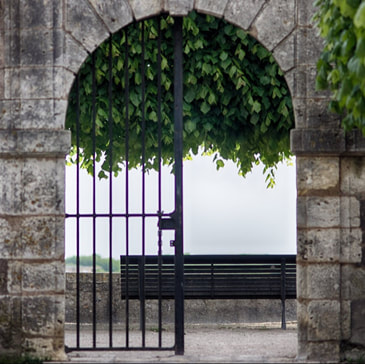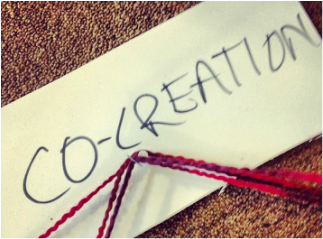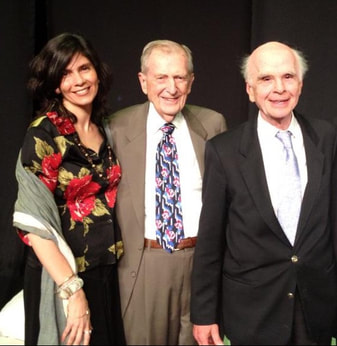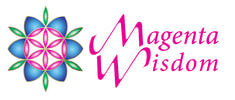 Note from the authors: We, Alan Briskin and Kathia Laszlo, have been in deep exploration on Unfolding Wisdom as part of the design process for an upcoming retreat on this topic. The retreat is meant for leaders, facilitators, consultants and change agents who are curious about the tension between intuitive knowing and its practical application in organizations and society. Our rich conversation has become fertile ground for our future time together. The following blog will give you a glimpse into our dialogue. We invite you to participate in it by sharing your own feelings and thoughts as comments to this post. The post begins with some initial reflections from Kathia, followed by a response by Alan. Kathia Laszlo: Unfolding Wisdomis the experience of not being in control and yet knowing in my bones that everything is well. That even when my mind can’t understand and my ego experiences fear, I can trust in a larger benevolent pattern that informs my life – because I have chosen to listen and to be in alignment with it. For me, this pattern is the pervasive consciousness of the universe that I experience as a gentle loving presence throughout my life. As an adult, I can now recognize that it was particularly alive when I was a child. Because of my Catholic religious upbringing, I am comfortable associating it with God, Jesus, the Holy Spirit and Mary. And through my spiritual expansion, I can also call it Goddess, Great Spirit, Mother Nature, Sophia. In all of those names are cultural references that reflect sparks of Divinity in the attempt to grasp it. They are fractals of interpretation, conditioned by our human ways, that belong to the unnamed luminescent totality. I have experience unfolding wisdom when I have been willing to go to the edge of my knowing and take one more step… that one risky step into the mystery. I have experienced unfolding wisdom when I had to stop listening to external sign posts and rely primarily on my own heart, my inner knowing, and trust that the embodied felt-sense of “yes,” even when it is soft and muffled by my critical mind and fear, is the guidance that I was hoping for. I have learned to lean more and more into this inner knowing because, regardless of the hesitation, I am consistently rewarded by a feeling of peace and joy resulting from my willingness to listen and follow it. I experience unfolding wisdom quite often in my work. For example, I had a meeting with a client. I sat across her at a coffee shop, and as both of us sipped our cappuccinos, I felt the sacredness of the encounter. The context was mundane; the purpose was holy. I recently learned from a friend that sacred also means sole focus or single purpose. Full dedication. And in that moment, I was fully present with her, fully listening with all my senses… it was a moment of connection, of communion, that enabled my capacity to assist her. Her life experience, her struggles, her dreams became entangled with mine. Or rather, I recognize that our stories are connected, that we are one, mirror images of each other. From that communion, I can become a conduit for the wisdom that goes beyond our two minds and that can only unfold in that moment, in that place, with her, for her. Everything I know, everything I have learned, my history and life experience, everything becomes relevant and informs what I am able to offer in the now. I sat at the edge of my chair, experiencing deep empathy and love, and ideas flowed through me. Her eyes had a spark, she was excited, she could sense the potential. It was as if many doors opened in front of us and they opened because, together, we created the key that unlock possibilities; the key that connects past and future, child and adult, mother and daughter, personal and professional, masculine and feminine; the key to wholeness. Alan Briskin: I am challenged by the premise I believe lies behind Unfolding Wisdom. The premise being that there is an implicate order, in the words of David Bohm, and what unfolds is already present, waiting to be manifested. If so, what underlying conditions help determine what emerges? How does one encounter the light and dark aspects enfolded within ourselves? How might the noise and rumble of the outside world (and our own minds) drive us away or bring us closer to an innate intuitive knowing. There is an intriguing legend of a Jewish Hasidic Master, the Baal Shem Tov. In the language of the Bible, the term Hesedis understood as loving kindness, directed toward a Creator as well as between fellow humans. Hasids were those who cultivated this loving kindness, opening themselves to be loved by an infinite force and to reflect that love back into the world. The Baal Shem struggled his whole life to embody this kind of grace, how to live with the felt sense of YES beautifully described by Kathia. The only problem was he was somewhat of an arrogant fellow, with temper tantrums and anger directed at those who didn’t deserve it. What distinguished the Baal Shem was his willingness to face his shadow side and shortcomings, to ask for help. And this is where the legend takes a sharp turn. For who does he summon for help but Satan himself, the dark angel, an outer manifestation of the shortcomings we have within. And Satan is not pleased, summoned from Heaven where he has access to God and free to engage in lively debates. “How dare you” Satan bellows. “How is it you do not fear me?” “I do not fear you,” the Baal Shem replies, “I stand in awe of Creation.” Satan is furious and refuses to help. But then something happens that changes everything. There is a moment of exquisite presence, a look of such compassion in the Baal Shem’s eyes that even Satan found himself drawn in, and he whispers to the Baal Shem secrets of how to transform one’s lower nature. These secrets, of course, cannot be revealed in a literal or prescriptive way because they are the result of an inner transformation. Baal Shem’s tale reminds us of the circuitous and often paradoxical forces that must be held in tension. Kathia reminds us that there is a fabric of meaning we are woven into and a social field we create that acts as a conduit of wisdom. The time is now to take this perennial wisdom out into the world, to be bearers of compassion and willing to call down, with less fear, the daunting forces from within and without. And we are more likely to do that together. The call is to create communities of practice, to live into emergent spaces that are both safe and brave. ~~~~~~~~~~~~~~~~~~~~~~~~~~~~~~~~~~~~~~~~~~~~~~~~~~~~~~~~~~~~~~~~~~~~~~~~~~~~ We invite your thoughts and comments What comments or questions arise from reading Kathia’s post? What feelings or memories are evoked from Kathia’s experience of connectedness and communion? What new questions arise from the possibility of an enfolded reality? What might this suggest about fate and determinism? What is the significance of the Baal Shem asking help from Satan? To learn more about the Wisdom Unfolding retreat, go here
0 Comments
 "Shared ownership" has been a theme that keeps coming up as I reflect on some of the challenges and opportunities I see in the organizations where I work. Shared ownership can involve the real material common property of resources such as in a workers-owned cooperative, or it can be more ethereal as in the sense of a community that shares the responsibility for the wellbeing of its members. Between these two extremes, there can be many variations. But the common thread is a sense of belonging, a realization that we are interdependent, that our collective wisdom is needed, and that what we do as individuals affects the whole. Elinor Ostrom, the first woman to win the Nobel Prize in Economics for her work on economic governance. Ostrom showed how common resources, like "forests, fisheries, oil fields or grazing lands, can be managed successfully by the people who use them, rather than by governments or private companies." The tragedy of the commons, as explained by ecologist Garret Hardin, has applied to numerous situations where we have lost many species and ecosystems because of private interests focused on maximizing their individual profit. However, as Ostrom demonstrated, it doesn’t apply to all cases. There are many groups and cultures around the world who have been successful in sharing ownership rights and responsibilities, finding the sustainable way of using the resources without depleting them. Shared ownership requires rules for how and when to access the resources, but above all, it requires trust: everybody needs to care for the commons, everybody needs to follow the rules. If someone pursues individual self-interest, the community as a whole suffers. Ostrom identified some "design principles" for the management of common pool resources (or CPRs), including: clearly defined boundaries of the CPRs, rules for the appropriation and provision of common resources, participatory decision making processes and effective communication, monitoring for accountability, sanctions for appropriators who violate the community rules, accessible conflict resolution mechanisms, self-determination granted to the community by higher-level authorities, and trust and reciprocity among the members of the community. From a social systems design perspective, these principles are guidelines for the design of multiple and diverse institutional configurations. Ostrom advocated for the design of organizational systems that use local knowledge to match the complexity, in terms of biological and cultural diversity, of each unique place. She disagreed with the view of a uniform top-down panacea involving private or public control of the commons. She proved that communities can self-organize for resiliency. I find her work inspirational and enabling. It provides us with research-based evidence of the opportunities to design new organizational forms. In my work with social enterprises, the issue of shared ownership is becoming increasingly important. Even if the legal structure is not of a formal cooperative, businesses or nonprofit enterprises who want to excel in their social missions need the full engagement of their employees and collaborators. Nonprofit organizations can engage its board members, staff and the communities they serve in an exploration of their common future, making sure that their individual needs and visions are part of the life of the organization. A for-profit can create democratic and participatory processes, sharing financial information with its employees, being transparent about their social and environmental practices, and sharing profits or giving stock options to increase commitment and belonging. Shared ownership is achieved when people feel they have a "stake" in the organization and its future, when they feel that the mission of the organization is aligned with their personal purpose, and when caring for the whole brings benefits to the individuals. Sharing ownership of a process or a purpose enables self-organization and the activation of the distributed collective intelligence. Shared ownership is a pre-condition for shared leadership.  One of the wonderful things about being part of Saybrook’s community is the opportunity to connect with and continue to learn from the faculty teaching in the different schools and programs. Ever since I was enrolled as a student in the late 1990s, I have been an admirer of the profound scholarship, intellectual brilliance, and refreshing humility of Stanley Krippner. Even though he was not my professor, except for a couple of seminars during residential conferences, I have always considered him my mentor. He has been an ongoing inspiration and supporter of my personal and professional evolution. Stan is a transcultural being. He has the ability to connect with humanity in all its diversity. In my relationship with him, he has always reached out to meet me in my Mexican womanhood while treating me as his friend and equal human fellow. Stan has been collaborating for several years with the Transpersonal Institute in Puebla, Mexico. Stan serves on their board and goes frequently to teach in Puebla. For the past year or so, this university has been organizing a congress on science and spirituality and Stan reached out to me to see if I had any recommendations of possible speakers. I took a couple of days to respond and was able to provide him with a couple of names. Next thing I knew, I was invited to present at the congress. When I saw the roster of the other 14 speakers, I had one clear reaction: I didn’t belong. It was a combination of feeling insufficient and stretched beyond my scope. I am very interested in the intersection of science and spirituality but that’s not the main focus of my work. And I just don’t have the level of accomplishment of the other “brilliant minds” (as the publicity for the event stated). But I knew perfectly what Stan was doing: nudging me gently to take a (bold) step beyond my current comfort zone. He has fully stepped into his role as an elder and, as such, he is a true supporter of younger generations. He believed I had something to contribute so I decided to listen and explore what that could be. After saying yes to the invitation to the event, it was evident that I was saying yes to a larger inquiry. The universe eagerly started to send me learning opportunities to grow into this new direction. This became apparent as I was preparing my presentation. I submitted my abstract more than seven months ago. The title was “Systems Science and Spirituality: Connecting Mind, Heart and Spirit for Healing Ourselves and Transforming the World.” As I was preparing my presentation, I was pleasantly surprised to notice how many of my experiences since then have been lessons on a topic that at the time felt more like an intention. My experience in the dialogue on recovering the soul of place at Wasan Island, my most recent experiences teaching at Saybrook, and my learning and experimentation with the Global Leadership Lab are a few examples. They have been spaces that have allowed me to experience a deeper way of being human: opportunities to experience healing and wholeness and the reintegration of the sacred in work and life. As I listened to the talks of some of my co-presenters, I found myself sitting at the edge of my seat. In particular, the presentations by Dr. Allan Combs, Rabbi Olivier Benham, and Dr. Amit Goswami where full of ideas that explained “the other side of my work”: the side that supports, grounds, and validates my approach to organizational systems. I am a scholar-practitioner, and my work has been to bridge the knowledge from academia with the practical needs of organizations and communities to address socio-ecological realities. My contribution is the translation of ideas into practices. And my current passion is creating the containers, the safe spaces, where people can experience and emotionally connect to the mind blowing findings from the new sciences—from quantum physics to consciousness research. I am interested in the creation of the “fields of resonance” where people can learn and experience collaboration and synergy to accelerate the emergence of ecosystems of social innovations. Public speaking always makes me nervous even when I’m in an intimate circle with collaborators. But there I was, on a stage, facing an audience of almost 2,000 people. I wasn’t too happy about my own presentation. The feeling of not being good enough didn’t go away. The inner critic that prevents us from giving freely our gifts is tough and persistent. I forgot to say a few things that I had planned to say and it took me a while to get into the flow of my narrative. But in the middle of my presentation, feeling a little bit more relaxed, I became aware (again) that my sincere intention to serve, to be a midwife of the new world that wants to be born, is probably more important than my words. My main message was around my current work that seeks to integrate being into doing. I am exploring the practical implications of transdisciplinarity: what ways of knowing, from the vast spectrum of human experience, have been excluded from science—and as a result, from business and culture—as the supremacy of rationality and objectivity was established? I am interested in re-membering (or re-connecting) the wisdom from the body, from the spiritual world, from nature. I want the voices of women, youth, children, indigenous peoples, ancestors and future generations of all species, to be heard, respected, and included in the decision-making processes and integrated in the design of solutions for our societal problems. I want the arts and humanities to be considered essential forms of inquiry; not tangential and optional forms of human expression, but core practices to heal and become whole humans. I want us to go back to our human origins when we knew—if only intuitively—that we are part of something much larger, participants in a sacred dance of being and becoming. During the break after my presentation, as I was trying to go and get coffee from the lobby, I was stopped by people in the audience who wanted to ask me more questions or express their appreciation. Knowing that I touched the heart of at least a few people in the audience and inspired them to embrace their search for purpose and service made this trip worthy. Some years ago, Stan called me an “organizational shaman.” I never forgot it but, at the time, I didn’t know what to do with that. A common dictionary definition says that a shaman is someone “who uses magic for the purpose of curing the sick, divining the hidden, and controlling events.” I once heard a presentation by Claire Zammit and Katherine Woodward Thomas where they defined feminine power as the magic to create what our heart longs for. Feminine energy is nurturing, supportive, and created through relating and connecting. “Magic” is another word for the emergence of possibilities from this relational field. “Health” shares the same etymological root as “whole” and “holy.” And one of the most potent insights of my work as a consultant is the acknowledgement that paying attention to the “invisible”—the consciousness and intentions of people, their values and cares, and the emotional network of relationships—can make a difference in producing the results we want. Those invisible dimensions are the topic of the exploration in the convergence of scientific and spiritual inquiry. So an organizational shaman can be seen as someone who creates the conditions for deeper connections—intellectual, emotional, physical, spiritual—that enable creative and emergent processes to bring back wholeness and facilitating the actualization of the organizational purpose as it contributes to the healing and transformation of our world. I think I am ready embrace that. Thank you Stan for gently nudge me in this direction. I love you. |
AuthorKathia Castro Laszlo, Ph.D. Archives
March 2019
Categories
All
|

 RSS Feed
RSS Feed